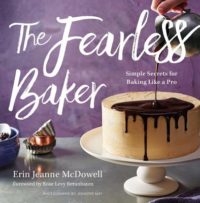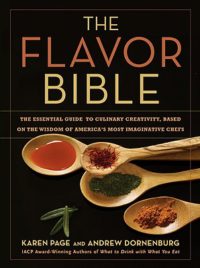Blog
Favorite Things: “Two Birds With One Stone” Chicken and Broth
The InstantPot craze hit the home cook/blogger world a couple of years ago and shows no sign of stopping. I admit, I was skeptical–after all, I already had a slow cooker and I had a pressure canner already, so what was the big deal? And then I got one and started inventing reasons to use it.
These days, it’s getting less attention, but the one thing I love it for is this awesome approach to making chicken and broth at the same time. Not only is it the fastest way to cook a whole chicken for use in other recipes, you get two bonus quarts of broth out of it. This is a life-saver during the holiday season because it allows me to a) get a jump on weekday dinners and b) control what goes into the broth I use for recipes all season long.
This recipe yields very “chicken-y” meat without much added flavor and a neutral broth suitable for most recipes. Feel free to adjust the ingredients to personal taste. I do not recommend adding garlic, as it tends to impart an off flavor to the broth when cooked under pressure.
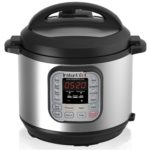
"Two Birds With One Stone" Chicken & Broth
Ingredients
- 1 3 to 4 lb whole chicken, thawed
- 1 tablespoon olive, canola, or sunflower oil
- 3 carrots, peeled and roughly chopped
- 3 ribs celery, roughly chopped
- 1 yellow onion, roughly chopped
- Salt, to taste
- 2 tsp whole black peppercorns
- 2 bay leaves
- 8 cups filtered water
Instructions
- If desired, remove skin from the chicken. Leaving the skin on provides more collagen to the final broth, but will make it more oily and tends to make the broth cloudier. I do both, depending on what I'm going to use the broth for, but I default to skin-off.
- Set your InstantPot to saute and wait until display reads "Hot." Heat oil for 30 seconds. Saute onions, carrots, and celery until beginning to soften and brown. Be careful not to burn as the InstantPot gets very hot very quickly!
- Place whole chicken on top of sauteed veggies. Sprinkle salt over chicken (I use about 1 tablespoon, but if you wish your broth to be low-sodium, use less.) Add peppercorns, bay leaves, and water. Turn off InstantPot to clear saute function, then select Manual High Pressure for 20 minutes. Close and seat lid, being sure to set the vent lever to closed.
- When your IP is done cooking, carefully release pressure. Remove chicken from pot and remove all meat from the bones. (I've found it's faster and easier to shred the chicken directly off the bone.) Return the chicken bones to the pot. Set on Manual High Pressure for 45 minutes. This will continue to enrich and deepen the chicken flavor of the broth.
- When broth is finished cooking, you may either release pressure manually or naturally. Place a fine-mesh sieve or a cheesecloth-lined strainer over a large bowl. Remove chicken bones and throw away, then pour the broth through the sieve to remove vegetables and spices. Refrigerate broth for 8 hours or overnight, then skim hardened fat from the surface. Keep refrigerated and use within 3 days or transfer to freezer-safe containers and freeze for later use.
Notes
Tags: chicken broth, chicken recipe, InstantPot
Ask A Reviewer (episode 1)
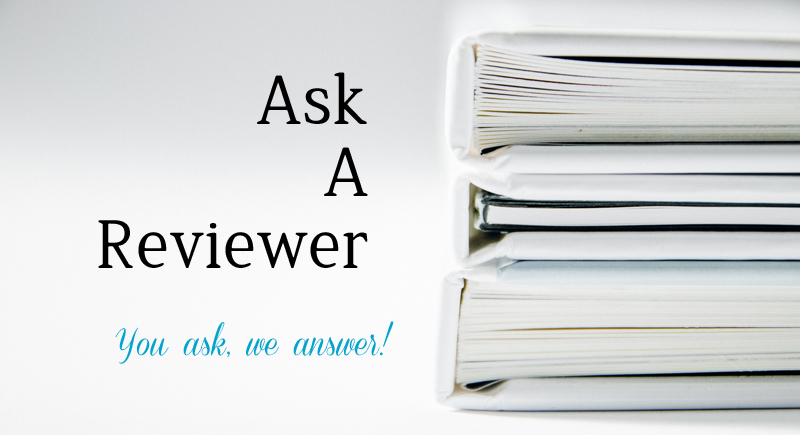
As an author, we all want to be original, avoid cliches, and distinguish ourselves from the competition. But with so many books being published every day, it’s nearly impossible to keep up with everything that’s available in our own market or genre.
So once a month we’re going to ask my panel of professional reviewers, who have a unique perspective on the Christian fiction market, one burning question on the minds of most authors. Let’s kick off the inaugural column with a nail-biter:
What one thing do you wish authors would stop doing in their books?
“Stopping the story for a sermon!! I love spiritual truth in the fiction I read but I love it best when it’s integrated organically into the story.” Carrie Schmidt, Reading Is My SuperPower
“Limit their own creativity. I love it when authors think outside of the box, or er…book in this case, and approach subjects, tropes, themes in a fresh and challenging way. Cookie cutter stories will put me to sleep faster than reading the phone book. I would tell authors not to be afraid to think beyond the boundaries, push the parameters and make beautiful art with their work.” Melony Peverett Teague, melonyteague.com
“Stupid or immature heroines!” Iola Goulton, iolagoulton.com
“Recently, the majority of self-published books that I’ve read have totally missed creating a main conflict or driving question for their entire story. They’ve written beautiful scenes and interesting characters without any tension. It pains me… Hiring an editor to go over the structure of their story would fix this problem, but understandably, a good editor is expensive.” Barbara Brutt, Cordially, Barbara
“I take issue with the freewheeling use of ‘devastatingly handsome’ or those ‘devastating blue eyes’! Pretty much any use of the word devastating to describe something appealing rather than, you know, actually devastating! ..There are plenty of other descriptive words in the English language which will stop me imagining the heroine crumbling to a heap upon the sight of such devastation!” Rel Mollet, RelzReviewz
“Model perfect hero/heroine. I understand the need but it would be nice to have more realistic heroes.” Andi Tubbs, Radiant Light
“I used to love them, but am getting a bit burned out on and tired of dual timeline stories…The writer must be equally good at writing historical and contemporary storylines and both must be given equal weight. What I’m seeing lately is that one side is much stronger than the other, and it makes me want to skim through the weaker side to get to the stronger one. And not just that, they need to be both integral to the plot, and if one side is a throwaway, it is glaringly obvious that the book is written that way because it’s trendy.” Melissa Parcel, Life Fully Booked
Thanks to my reviewer panel for their candor! I don’t know about you, but I’m making sure to avoid these pitfalls on the next book.
If you’ve got a question for our reviewer panel, leave it in the comments below and we may answer it for you next month!
Tags: Ask a Reviewer, writing tips
Favorite Things: Cookbooks
It seems appropriate as we head kicking and screaming enthusiastically into the holiday season that my Favorite Things feature deals with food. After all, most of us will be experiencing about six weeks of food-related panic ecstasy as we cook and bake and gift our way through Thanksgiving and Christmas. So here are the five cookbooks you should have on hand to survive the upcoming season of culinary madness.
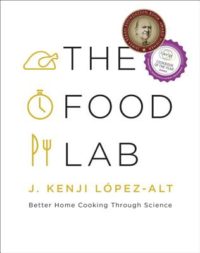 The Food Lab, by J. Kenji Lopez-Alt
The Food Lab, by J. Kenji Lopez-Alt
If you took Bill Nye the Science Guy and made him a thirty-something Asian culinary science geek, you’d get J. Kenji Lopez-Alt. This book is my number one recommended cookbook and the pretty much the only book I would ever need, were I forced to choose. You’re not going to find a lot of fancy sauces or molecular gastronomy or anything in these pages. Just a scientific and well-researched approach to the very best way to cook all your favorites, from scrambled eggs to fried chicken to mashed potatoes. It’s a bit like a culinary education for the bargain price of $35. And this thing is no lightweight… it tops out at 958 pages, plus appendices. Trust me, dedicate a couple weeks of evenings to reading this and you’re going to suddenly feel like Wolfgang Puck. Minus the accent. Probably.
Recipe to Try: Roasted Butterflied Turkey with Gravy, page 612.
To Buy: Amazon | Barnes & Noble | IndieBound
Bravetart, by Stella Parks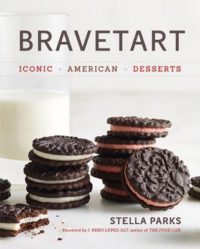
I’m not gonna lie, I’ve got a serious foodie #girlcrush on Stella Parks. I’ve followed her column on Serious Eats for a while, and I love her moxie as much as her recipes. This cookbook was on my most anticipated list for the year, and it’s flat-out great. The concept of the book is reinventing iconic and heavily processed American desserts in new and fresh ways, from Oreo cookies to Cracker Jack to homemade Hershey’s syrup. It might be a bit of an overstatement to call this life-changing, but it’s my go-to book when I want something from my childhood that my food sensitivities prevent me from eating.
Recipe to Try: Chopped Chocolate Chip Cookies, page 34.
To Buy: Amazon | Barnes & Noble | IndieBound
The Fearless Baker, by Erin Jeanne McDowell
This is my second most-anticipated cookbook of the year, and like Bravetart, it was worth the wait. I look at this one like The Food Lab for bakers: each recipe gives an explanation of why it works and how to change things up. While I haven’t made a ton of recipes from this one yet, I’ve applied the tricks and tips to my most problem recipes with stellar results. This is one of those books that gives you confidence to tackle things you’ve never had the courage to attempt.
Recipe to Try: Buttermilk Biscuits, page 25
*Note: The linked recipe uses twice as much baking powder as the book recipe, but is otherwise identical. Since I’m baking at altitude, I would go with 1T only to prevent the biscuits from over-rising. YMMV.
To Buy: Amazon | Barnes & Noble | IndieBound
Damn Delicious, by Chungah Rhee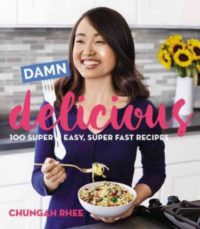
After the first three “serious” cookbooks, you might be asking what this slim volume from a blogger is doing in the mix. This is your ace in the hole, my friends. Every single recipe in this book is, ahem, darn delicious and guaranteed to please the picky eaters in your family. Are they things you couldn’t find on Pinterest? No, they’re pretty straightforward. But the recipes are well-tested, tasty, and best of all, fast. This is the book I reach for when I’m completely brain dead after a long day of writing and the last thing I want to do is meal-plan. Or search the internet. Or find my phone. Pick it up and thank me later.
Recipe to Try: Asian Garlic Noodles, page 71
To Buy: Amazon | Barnes & Noble | IndieBound
The Flavor Bible, by Karen Page and Andrew Dornenburg
This one isn’t specifically a cookbook—you won’t find a single recipe inside. What it is is a master class on flavor paring, organized like a dictionary. For those of you who are ready for a bit more of a challenge, this can help you figure out what flavors go together when you’re cooking on the fly…or like me, forget to go grocery shopping and decide to make dinner into an impromptu Chopped: Home Edition episode. But even if you’re not a cook-by-the-seat-of-your-pants type, this book has one huge benefit. Substitutions. Out of an herb, spice, or vegetable? Flip to the sections that detail the main ingredients in your dish and see what else goes with those flavors. This is my get-out-of-jail free card, and I’ve turned many an uh-oh into a new favorite recipe. Most pages also include quotes from well-known chefs and examples of their signature dishes for inspiration.
To Buy: Amazon | Barnes & Noble | IndieBound
Hope this helps you on your way to holiday sanity. If you try these and find any new favorites, let me know!
Tags: Christmas, cookbooks, Thanksgiving
Forget Publishing and Write.
This is the post in which I crack the code of having a long and successful writing career. I know everyone says they have the secret—and lots of them will tell you it for the bargain price of $299 per webinar—but most of them are missing the core thing that will make you from a wanna-be writer into a seasoned professional.
Are you ready for it?
Write.
Huh, you’re saying. No one’s ever told you that you have to write to become a writer. But hear me out.
Back when I started writing novels, the internet didn’t exist as much more than a place to create a bad personal website with a colored, tiled background and flashing animations. There weren’t two hundred (plus) blogs on writing. There weren’t multiple writing organizations—well, there were, but because of no internet, I didn’t know anything about them. I had to check out craft books from the library, and I bought the The Writer’s Market doorstop every year. And it made me a better writer.
Not because I think it builds character to dig through a card catalog in the library, but because there was less noise. No one telling me which publishing path I should take. No one telling me that my genre was dead, or this is the next big thing, or that no one buys contemporary romance anymore. Because by the time I was actually able to write a publishable book, all those things had changed. You can study as much as you want about the business side. You can follow trends, research genres, and find your perfect cover designer, but none of it means a thing until you put words on the page.
Lots of words. Thousands of words. Even better, hundreds of thousands of words.

Very few writers come out of the womb fully formed as a bestseller. Most authors never get their first book published (and those who do most likely have a background in a complimentary field, like screenwriting, short fiction, or commercial freelancing.) Most writers like me have handfuls of old manuscripts that will not and should not see the light of day. I’m so embarrassed by my first three attempts at a novel that I’ve destroyed the files… just in case I someday become famous and someone wants to pull a Go Set a Watchman on me. There’s a reason I couldn’t get those books published. They shouldn’t be published. They. Weren’t. Good. Enough.
And yet because of the ease and ubiquity of self-publishing*, I get e-mails from new writers wanting to know who they should hire as an editor or who’s the best publisher for their book, before they’ve written The End on their first work.
Like a runner training for a marathon, logging hundreds of miles in preparation for the long haul, writers need their own training period. Every failed attempt at a scene or a chapter puts you that much closer to a success—because now you know what not to do. Every rejection from an agent or an editor—especially when you get that Holy Grail feedback—is one step further along your writing journey. Once upon a time, when the market wasn’t so crowded and competitive, writers with talent might be able to land a contract and develop their skills with the help of an editor. Now, the market is tighter than ever, flooded with published authors who have lost their houses because of mergers and line cancellations. In order to catch the eye of an editor or agent, you need to be putting out your best work every single time.

So put aside your market guide and write. Read books in the genre you love and analyze what makes them successful. Study chapter lengths and the hooks at the end. Analyze character development. Read craft books from recognized professionals. Go to conferences and take craft classes (but bypass the marketing for now). And once you’ve written your hundreds of thousands of words and you know that you’ve crafted the best novel you can, come back and dive into the world of publishing. It will still be waiting for you.
*I’m not against self-publishing at all. I’m simply against it as a shortcut through learning the writing craft. Not only does rushing to publish do the reader a disservice, it potentially harms your future career. Readers often only give a new author a single chance before they put them on the “never buy” list and tell all their friends, and editors and agents would rather a writer have no track record than a bad track record.
Tags: apprenticeship, craft, publishing, self-publishing, writing

